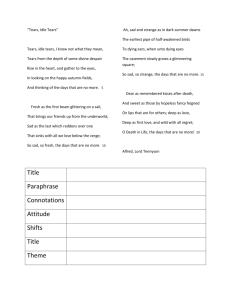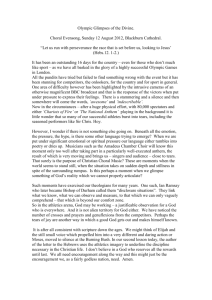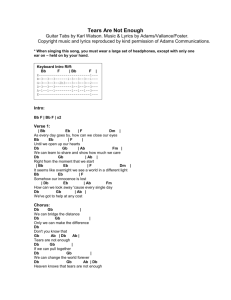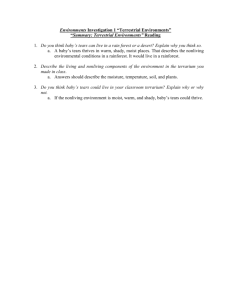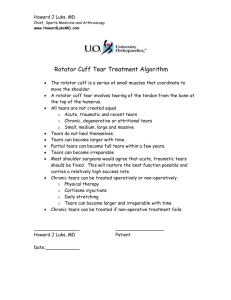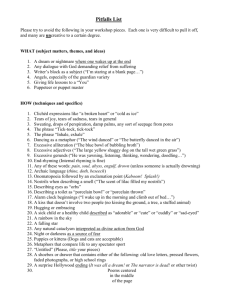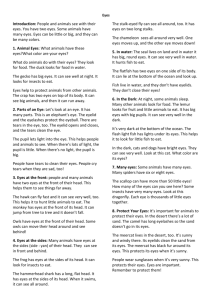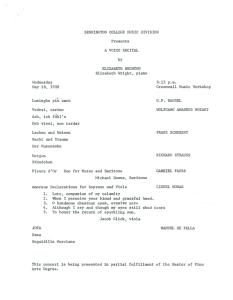EXPERIENCING TEARS OF WONDER
advertisement
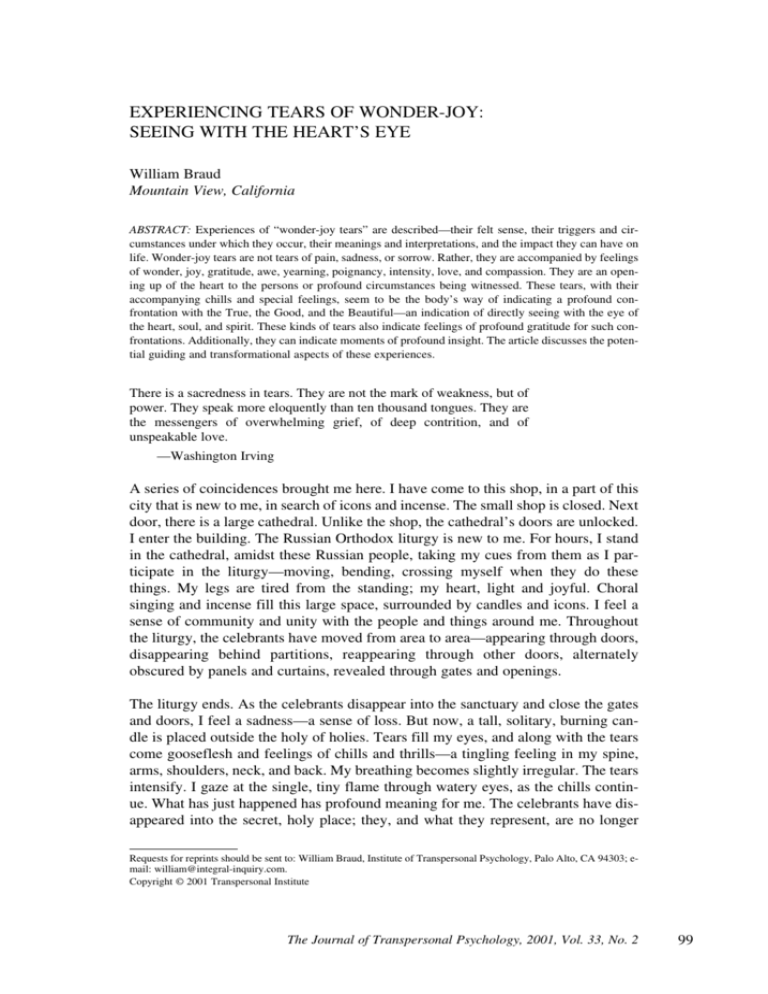
EXPERIENCING TEARS OF WONDER-JOY: SEEING WITH THE HEART’S EYE William Braud Mountain View, California ABSTRACT: Experiences of “wonder-joy tears” are described—their felt sense, their triggers and circumstances under which they occur, their meanings and interpretations, and the impact they can have on life. Wonder-joy tears are not tears of pain, sadness, or sorrow. Rather, they are accompanied by feelings of wonder, joy, gratitude, awe, yearning, poignancy, intensity, love, and compassion. They are an opening up of the heart to the persons or profound circumstances being witnessed. These tears, with their accompanying chills and special feelings, seem to be the body’s way of indicating a profound confrontation with the True, the Good, and the Beautiful—an indication of directly seeing with the eye of the heart, soul, and spirit. These kinds of tears also indicate feelings of profound gratitude for such confrontations. Additionally, they can indicate moments of profound insight. The article discusses the potential guiding and transformational aspects of these experiences. There is a sacredness in tears. They are not the mark of weakness, but of power. They speak more eloquently than ten thousand tongues. They are the messengers of overwhelming grief, of deep contrition, and of unspeakable love. —Washington Irving A series of coincidences brought me here. I have come to this shop, in a part of this city that is new to me, in search of icons and incense. The small shop is closed. Next door, there is a large cathedral. Unlike the shop, the cathedral’s doors are unlocked. I enter the building. The Russian Orthodox liturgy is new to me. For hours, I stand in the cathedral, amidst these Russian people, taking my cues from them as I participate in the liturgy—moving, bending, crossing myself when they do these things. My legs are tired from the standing; my heart, light and joyful. Choral singing and incense fill this large space, surrounded by candles and icons. I feel a sense of community and unity with the people and things around me. Throughout the liturgy, the celebrants have moved from area to area—appearing through doors, disappearing behind partitions, reappearing through other doors, alternately obscured by panels and curtains, revealed through gates and openings. The liturgy ends. As the celebrants disappear into the sanctuary and close the gates and doors, I feel a sadness—a sense of loss. But now, a tall, solitary, burning candle is placed outside the holy of holies. Tears fill my eyes, and along with the tears come gooseflesh and feelings of chills and thrills—a tingling feeling in my spine, arms, shoulders, neck, and back. My breathing becomes slightly irregular. The tears intensify. I gaze at the single, tiny flame through watery eyes, as the chills continue. What has just happened has profound meaning for me. The celebrants have disappeared into the secret, holy place; they, and what they represent, are no longer Requests for reprints should be sent to: William Braud, Institute of Transpersonal Psychology, Palo Alto, CA 94303; email: william@integral-inquiry.com. Copyright © 2001 Transpersonal Institute The Journal of Transpersonal Psychology, 2001, Vol. 33, No. 2 99 accessible. Yet the single burning taper remains. I feel the sun has been taken away, hidden; but the spark remains as reminder and promise of the greater light that, although unseen, may be subtly sensed. The solitary candle is a tiny spark symbolic of, reflecting, a greater sun within. Eventually, the tears stop; the chills cease caressing my spine. I feel a profound gratitude. Another occasion: A new library is being dedicated. I stand in a crowd on a crisp, sunny morning. I have been shifting position from time to time, seeking shadows to keep the sun from my eyes. Throughout the ceremony, there have been many moving moments. At the close of the program, the mayor shares a Native American story about telling one’s secret wish to a butterfly’s wings. The butterfly will keep the secret and take it to the sky. At this point, small children release butterflies. Many butterflies flutter upward, into the sky. Tears fill my eyes. Chills visit my spine. What I am witnessing is moving and meaningful to me. The tears and chills increase, persist. An orchestra of children begins to play. More butterflies take flight. My eyes fill with more tears of joy and wonder and gratitude. I have had such experiences many times. I have come to call them tears of wonderjoy. The tears and chills are, to me, my body’s way of indicating that the eye of my heart is open and functioning and encountering something of vast importance and meaning. I have come to recognize these wonder-joy tears as direct responses to the true, the good, the beautiful. Such tears are not tears of pain or sadness or sorrow. Rather, for me, they are accompanied by positive affect—feelings of wonder, joy, gratitude, yearning, poignancy, awe, intensity, love, and compassion. With them comes a feeling that my heart is going out to what I am witnessing. The tears, chills, and special feelings come upon me, unexpectedly and spontaneously, as experiences of grace—as bodily signals, signs, or indicators of encounters with the numinous; as my body’s way of letting me know I am having an unplanned, unavoidable encounter with the Real. In this article, I describe my personal experiences of wonder-joy tears. I relate the circumstances under which these experiences occur and the meanings I have come to attribute to them. I describe the similar experiences of others, sharing their firsthand accounts and mentioning their interpretations of these experiences. What are their physical reactions and accompanying feelings? What elicits these reactions and feelings? What impact do tears of wonder-joy have on our lives?1 A brief account of how I came to call these experiences “wonder-joy tears”: In the early 1970s, I was preparing the earth for a vegetable garden and was listening, as I worked, to a portable radio. I happened to tune in a station in the midst of a reading of a short story which I learned, at the end of the broadcast, was a tale by H. G. Wells called “The Door in the Wall.” It was, for me, a story of a special Something More beyond our everyday experiences. It was also a story of lost opportunities, of how habits and duties distract and prevent us from encountering that for which we secretly yearn. Eventually, I was able to find the story in a collection of Wells’ tales, and it became a favorite of mine—one that I read often. In the early 1990s, while reading this tale once again, my attention was drawn to this passage. 100 The Journal of Transpersonal Psychology, 2001, Vol. 33, No. 2 You know, in the very moment the door swung to behind me, I forgot the road with its fallen chestnut leaves, its cabs and tradesmen’s carts, I forgot the sort of gravitational pull back to the discipline and obedience of home, I forgot all hesitations and fear, forgot discretion, forgot all the intimate realities of this life. I became in a moment a very glad and wonder-happy little boy—in another world. It was a world with a different quality, a warmer, more penetrating and mellower light, with a faint clear gladness in its air, and wisps of sun-touched cloud in the blueness of its sky. (Wells, 1927/1952, p. 148) The phrase “very glad and wonder-happy” suggested a term for which I had been searching to describe the tears-and-chills experiences I so often had. “Wonderhappy” became “wonder-joy”—a perfect prefix, I felt, for these particular tears. Thus I began to use the term as a shorthand code for these special kinds of tears and for the fuller bodily and affective experiences that accompanied them. THE FELT EXPERIENCE Tears such as Angels weep, burst forth. —John Milton (“Paradise Lost,” I.620) I am witnessing a scene or occurrence that calls forth tears of wonder-joy. It is a scene or activity that moves me deeply. Tears quickly fill my eyes. My skin erupts in gooseflesh, hairs standing on end. Something literally takes my breath away; I gasp, involuntarily. Chills run up and down my spine. I feel a tingling around my eyes, my head, and the back of my neck. The tone of the experience is positive. Toward the end of the experience, or afterwards, there may be some sadness. In the midst of the experience I feel love and compassion. My heart goes out to what I am witnessing. I feel gratitude. I feel a yearning, a poignancy, an intensity. Around me, and between me and the provoking event, there is what I can only describe as a thickness, as though the surrounding air somehow has a greater density. The experience comes upon me—unexpected, spontaneous. My attention is focused strongly upon what I am witnessing, what is provoking these feelings. I am strongly aware of the feelings themselves and the sensations that are being provoked. Other things fade from my attention. The rest of me pauses, shuts down temporarily. If I try, later, to describe the event that initially brought forth the wonder-joy tears, the tears may occur even more strongly than they did initially, and I weep. Sometimes, I am unable to relate the incident that originally provoked the tears—the feelings and the weeping are too intense. I must cease, and allow the feelings to subside before I am able to continue. I have had a tremor of bliss, a wink of heaven, a whisper And I would no longer be denied; all things Proceed to a joyful consummation. (Eliot, 1980, p. 209) Curious about others’ experiences, I query colleagues and students about their wonder-joy tears. From their reports, I learn that in such circumstances, always, there are the tears. Often, there is gooseflesh. Sometimes, there are the chills and thrills— electrical or tingling feelings in the spine, arms, shoulders, neck, and back. (The French have a special term for this—frisson: shiver, shudder, quiver, thrill.) More Experiencing Tears of Wonder-Joy: Seeing with the Heart’s Eye 101 rarely, there is an involuntary gasp, an irregularity in breathing, or a vocalization (“oh!” or “ah!” or “uh!”). Some report a feeling of warmth throughout the body. Others report warm, soft colors. Still others report a pulsing, expanding, aliveness in the chest area that may extend for three to four feet. Sometimes there is a quiet, gentle sobbing. In connection with this experience, all report positive affect. There are feelings of joy, peace, and awe; feelings of love, compassion, empathy, and acceptance; feelings of unity, union, oneness, closeness, connection, and immersion. Some report a congruence of themselves and all life. There are feelings of gratitude, blessedness, intensity, yearning, poignancy. Some report feeling cleansed, renewed, a beginning. For some there is a feeling of being at home, of recognition, of safety. Others experience a lightness, a spaciousness, an expansion, a feeling of being uplifted, soaring. Some feel a release, freedom. There may be feelings of deep satisfaction; of being accompanied and not alone; of being fulfilled, loved, fully seen, known, held, released from the need to be fully responsible for one’s own way or in charge; of daring to be vulnerable. More rarely, there is an experience of the facade cracking, of the surreal, of timelessness. There may be a paradoxical appreciation, a holding of opposites: joy/sadness, bitter/sweet, tragic/beautiful, confused/clear, amazed/normal. Some report sadness near the end of the experience.2 In terms of attention, there is a “stopping” at various levels. Attention is very focused, one-pointed—focused on the precipitating event and on the experience itself. Awareness of all else fades. Yet, there is awareness of a fuller spectrum of existence. Just as the head is a part of the body, thoughts may be parts of the wonder-joy tear experience. However, these are thoughts that usually occur later, in the wake of the experience itself. Thoughts such as the following arise in the mind: These moments await us, are latent, under the surface. Why are these not more frequent? Why are they often absent? Why are they exceptions, rather than the norm? Life can be messy/tragic and exquisite. This kind of experience is what really matters. We have gone astray. In summarizing his wonder-joy experience, one respondent said Tears are always mixed with feelings of exaltation, as if a transcendent dimension has been reached, as if the sacred has penetrated the mundane and come to earth. During these moments, everything feels serene and transformed. Although “happiness,” “joy,” and “peace” are part of the experience, these terms fail to catch the essence of these moments. As I hear mention of chills, gooseflesh, and hairs standing on end in many of the accounts of wonder-joy tears, I recall Plato’s (trans. 1993) ruminations on the feathering of the soul. In the Phaedrus, Plato likens the form of the soul to the combined capacities of a team of winged horses and their winged charioteer. In crafting this metaphor, Plato suggests that when a soul is perfect, it has wings and travels through the sky, helping to govern the cosmos. That which is noble, wise, and good nourishes the wings of the soul and makes them grow. Shame, evil, and the like are 102 The Journal of Transpersonal Psychology, 2001, Vol. 33, No. 2 detrimental to the wings and can destroy them. If the soul loses its wings, it drifts along until it grasps an earthly body and settles down, animating the body. Only the thinking of the friend of wisdom will make the wings grow, because, through memory, it is always as close as possible to that which by its proximity makes a god divine. When a man deals correctly with remembrances of this sort, he is always initiated perfectly into perfect mysteries, and he alone becomes perfect. Since he stands apart from the busy antics of humankind and draws close to the divine, he is rebuked by most people for being out of his wits. They do not realize that he is possessed. . . . Whenever someone sees beauty in this world he is reminded of true beauty and his wing-feathers grow. . . . When the recent initiate . . . sees a godlike face or some form of body that imitates beauty well, he at first gets goose bumps. . . . He is awestruck, as though he were gazing upon a god. . . . As he looks at him, his goose bumps go away and an unusual warmth and sweating seizes him. He is warmed by the effluence of beauty he receives through his eyes, which naturally moistens the wing-feathers. . . . and as the nourishing moisture flows over them, the shafts of the feathers swell and begin to grow from their roots over the entire form of the soul, which was feathered all over before. . . . Mortals do indeed call the winged one Eros (Love), but immortals call him Pteros (Feathered), because he necessarily develops wings. (Plato, Phaedrus, 249c-252b)3 Could the experience of wonder-joy tears be the equivalent of the soul’s feathering confrontation with forms of beauty that evoke reminiscences of a supermundane realm? In the quoted passage, Plato’s mention of being “possessed” also strikes a resonant chord for me. In the midst of wonder-joy tears, I do, indeed, feel possessed—my body and feelings captivated and enraptured in the experience. As I dwell on the wonder-joy experience and its meaning, I come to appreciate more fully the last sentence of the quotation. I begin to feel that wonder-joy tears are indications and expressions of love. TRIGGERS (CIRCUMSTANCES) OF THE EXPERIENCE In any really good subject one has only to probe deep enough to come to tears. —Edith Wharton (The Writing of Fiction, 1925) I recall circumstances that have provoked my experiences of wonder-joy tears. In addition to the solitary candle and butterfly incidents mentioned earlier, I remember the following occasions: • Seeing a watercolor painting by kindergarten children on “one big happy community”— crude yet colorful continents with hands reaching out for one another • In a filmed version of John Steinbeck’s Of Mice and Men, watching the gigantic, slow Lenny stroking a tiny mouse • Witnessing the simple, natural acts of animals—good, innocent, artless • Witnessing anything that is truly honest, open, free from guile or craft • Finding a small bit of milk, unexpectedly, in the refrigerator, when I “knew” there was none left, and it being just enough to go with cereal—being overjoyed at such a simple Experiencing Tears of Wonder-Joy: Seeing with the Heart’s Eye 103 surprise and being grateful that I could be so moved by something so simple; knowing that my wife would appreciate this and be similarly moved, and that this simplicity is something we share • As part of my work, reading proposals and dissertations in which the goodness and spiritual light of the writer shines forth from the pages • Toward the end of, and immediately after, an experience of timelessness in which I lost awareness of my ego and individuality and merged with or became all that is, and was so thankful for having been blessed with such an experience • Attending a performance of a particular entertainer after having wanted to do this for about 35 years, and having narrowly missed several opportunities • When someone has related a very meaningful or profound experience that I, too, have had and have been very moved by—a feeling of sharing, of common experiences, or of common values or joys • Witnessing certain profound synchronicities (meaningful coincidences) • Witnessing miracles in which somatic conditions about which I was worried were instantaneously corrected or healed; accompanying this was extreme gratitude and great feelings of thankfulness, faith, hope, and love • Witnessing, thinking about, or remembering the goodness, simplicity, and innocence of particular persons I know or have known • Reading my own deeply held truths in the writings of others and feeling a kindred spirit in the writer • Being in the presence of a sage—a wise, holy, old woman—in Athens • Appreciating the meaning of certain buildings at the Acropolis in Greece—how truths and lessons were dramatized, communicated in permanent structures. Connected to this was a feeling of the meaning of the gods, goddesses, and archetypes; an anger and frustration at not having been taught such simple, true things many, many years ago; and a delight that I had at last seen and understood such simple, true things • Realizing, suddenly, that I might be printing, on the feast of the Epiphany, the final copy of a book whose seeds had largely been sown 5 years earlier on another Epiphany, and remembering all of the curious, synchronistic occurrences that had happened on or very close to the three intervening Epiphanies • Events that work out just right—sometimes with a feeling of relief, of being protected, watched over, cared for, or guided by unseen forces • A student reading, in one of my classes, the “Tale of the Sands,” a Sufi story in which I recognized so much more this time than on other occasions—especially the wind/spirit connection and the role of surrender, trust, letting go of the concrete body, of individuality, in order to move to another realm • Reactions to certain mystical poetry and passages • Considering the devotion, dedication, and energy that science fiction writer Philip K. Dick put into trying to understand his strange experience, and the energy, learning, and seeking he poured into his Exegesis—millions of words and years of work • A guided imagery exercise in which I experienced a wonderful ball of light on the banks of a stream near a cliff. The light led me to a cathedral, and I was filled with awe, wonder, and a feeling of the numinous • Seeing a television advertisement that features a view of the many intricate muscles of the human back and appreciating, with awe, Nature’s wondrous architecture, design, and wisdom • An image and feeling in meditation of standing on the Earth at the bottom of the sea with my upper body in the air, reaching for the fire of the sun—feeling large, balanced, and complete • Seeing a Twilight Zone television episode, decades ago, called “Next Stop Willoughby”—about an “ideal,” simple, uncomplicated community 104 The Journal of Transpersonal Psychology, 2001, Vol. 33, No. 2 • Reading a message about someone’s 4-year-old daughter who asks her father, “When I’m old and then I die and then I’m a baby again, are you going to be my daddy again?” • Experiencing Nature’s beauty—for example, the coastal mountains shrouded in morning mist • Certain musical selections, especially those featuring cellos or violins • Reading accounts of other people’s experiences of wonder-joy tears As I prepare this listing, I often re-experience wonder-joy tear feelings. I relish this experience. I am curious about what these circumstance may have in common, and I ponder the qualities they share. I ask others about circumstances that have elicited wonder-joy tears, and the following triggering events emerge: • Witnessing good or noble acts • Witnessing innocence or simplicity • Witnessing gentleness or kindness • Witnessing beauty • Witnessing intelligence • Witnessing displays of courage, bravery, and integrity • Witnessing someone’s desire to be of service • Experiencing the holy, the numinous • Experiencing connections, closeness, union • Experiencing understanding • Experiencing empathy, affinity • Experiencing what is given freely • Experiencing “myself out there” • Connecting to the larger “circles of life” when not doing, thinking, or planning • Experiencing need • Reading experiences of wonder-joy tears • Experiencing nature • Experiencing a quality of stillness • Making an effort to connect with an experience of the Divine through meditation • Finding—in writings, depictions, or actions—clear expressions of what I hold most important, meaningful, or dear Apropos of precipitating events, one respondent reports the following: It is generally an experience of humble loving goodness that prompts this response. A child rescued by a firefighter, a young woman who succeeds in not taking a drink, a mother who learns to appreciate her child, or a street person who is caring for his dog. These are experiences which are moving or touching or deeply felt or redeeming. Another respondent writes: Central to all of these experiences is the sense that the human beings involved have achieved what they were somehow meant to be. They behave in exalted ways that demonstrate their divine, transcendent potential. It’s as if the distance separating the Absolute and the human has been overcome, like God touching Man on the ceiling of the Sistine Chapel. Experiencing Tears of Wonder-Joy: Seeing with the Heart’s Eye 105 Another way to say this: Wonder-joy tears are evoked when I experience and see in others displays of courage, bravery, and integrity in life-and-death situations. These qualities have always been considered part of an impeccably lived life. Contact with the virtuous side of life is both wonderful and joyous—wonder-joy. MEANINGS AND INTERPRETATIONS OF THE EXPERIENCE Tears, idle tears, I know not what they mean. —Tennyson (“The Princess,” IV) What do my wonder-joy tear experiences mean to me? In response to prolonged inner questioning, some clues have arisen. For me, wonder-joy tears are responses to encountering and appreciating what is truly important. They are responses to what is innocent, unspoiled, uncomplicated, artless. To me, they are bodily indications of the functioning of the eye of the soul, of the spirit, of the heart—direct responses to the true, the good, the beautiful, the sacred.4 Tears of wonder-joy are somatic concomitants of my profound gratitude for encountering clear, pure, unambiguous instances or manifestations of the innocent, unspoiled, uncomplicated, and artless. Such tears are an appreciation of what could be or should be but has been missed, or from which we have gone astray—of what is less common than it could be. The experience of wonder-joy tears is an innate, automatic “empathy indicator” or “compassion indicator” or “gratitude indicator.” For me, the experience is also a bodily indicator of profound insight into my own nature and the nature of others and the world. Once, when I was keenly interested in behavior and ethology, I studied what used to be called “instinct” but which has more recently come to be called the eliciting of “fixed action patterns” by “releasing stimuli” (all innately determined). Nature seems to have programmed the nervous systems of animals to respond in certain fixed ways to particular cues in the environment. Such response patterns are functionally adaptive; they occur in the service of, and support, survival. Small birds respond, innately, with distress and avoidance to shapes that resemble the shadow of a predator hawk. A dominant wolf ceases its aggressive actions when a submissive wolf assumes a posture that exposes its vulnerable neck. Creatures with unusually large head size to body size ratios (as are found in the young of many species, including human infants) elicit caring and nurturing reactions on the part of adult animals. I sometimes think of wonder-joy tears as a sort of fixed-action pattern that occurs in response to specific releasing stimuli. The tears may serve as signals or tools, if we heed them, for discerning what is right, good, important, and authentic in a nonegoic sense. Stated more poetically, wonder-joy tears may be signals or signs of an encounter with the numinous—an unplanned, unavoidable encounter with the Real. They may indicate that the veils of maya have been pierced—that the windows of perception have been cleansed so that we can see more clearly, more lucidly. Wonder-joy tears may provide clues that the real me, the real person, real reality (the “big” rather than the “little,” the authentic rather than the false) is being confronted, appreciated, experienced.5 106 The Journal of Transpersonal Psychology, 2001, Vol. 33, No. 2 My own wonder-joy tear experiences—especially near their endings—are sometimes tinged with sadness; they have a bittersweet quality. The sad, bitter aspect may have to do with an appreciation of how far the “usual” has strayed from what could be, how we so often miss the mark. There is a yearning for some goodness or beauty that is intimated but which is not sufficiently present. Edgar Allan Poe seems to have captured some of this meaning in his essay “The Poetic Principle”: And thus when by Poetry—or when by Music, the most entrancing of the Poetic moods— we find ourselves melted into tears—not as the Abbaté Gravia supposes—through excess of pleasure, but through a certain petulant, impatient sorrow at our inability to grasp now wholly, here on earth, at once and forever, those divine and rapturous joys, of which through the poem, or through the music, we attain to but brief and indeterminate glimpses. (Poe, 1850/1938, p. 894) I ask others what wonder-joy tears mean to them—how do they interpret or understand these experiences? From their answers, the following meanings emerge: • Wonder-joy tears signal an encounter with what is true, authentic, good, beautiful, real • They are an indication of spontaneous compassion and empathy • They have to do with grace, gratitude, humility, awe; they are a gift • They indicate a certain clarity of perception • They are a reminder or indicator of having strayed • They are indicators of unity, of lack of separation; they remind us that separation is an illusion • They are recognitions of “what I really am,” recognitions of what is important to me but is sometimes missing: I am that and I am not always that • They are a blessing • They indicate newness, rebirth, growth • They are an experience of the essence of life • They indicate surprise • They are a sign of letting go • They are feelings of the presence of the divine • They are affirmations of meaning, of that which is Greater, of the connectedness of all things • They are indications of the functioning of the eye of the heart, the soul, the spirit • They are psychophysiological indicators of a particular state of being • They are our natural state In the words of one participant in this inquiry: During these moments I feel one enters a larger form of consciousness than the everyday, a dimension of the psyche in which individual minds are not separate. Schopenhauer once asked why an individual would give his life to save another person. It’s because, he answered, that at the critical moment he has become one with the individual for whom he’s giving his life; there is no “other,” only a single, shared experience that unites the two as one. In this sense, one does not give one’s life for another; one is the other. Is this an expression of the One Mind that many wisdom traditions talk about? [An experience such as this] is a window to something more real than everyday forms of consciousness. In the listing above of meanings and interpretations, a respondent mentions that Experiencing Tears of Wonder-Joy: Seeing with the Heart’s Eye 107 wonder-joy tears may reflect a simultaneous recognition that one is, or possesses the qualities, of what one is witnessing in such a moment and a recognition that one is not entirely that or always that. I feel the sense of this revelation is perfectly captured in a passage in Augustine’s Confessions (trans. 1971): “What is that which gleams through me and strikes my heart without wounding it? And I shudder and I glow. I shudder, in so far as I am unlike it. I glow, in so far as I am like it” (XI, IX[11]). IMPACTS AND CONSEQUENCES OF THE EXPERIENCE None are so desolate but something dear, Dearer than self, possesses or possess’d A thought, and claims the homage of a tear. —Byron (“Childe Harold,” II: xxiv) In the momentary experience of wonder-joy tears, there is pleasure, joy, and a feeling of participating fully in something moving and profound. These feelings are revived when I relive the experiences through memory. If pleasure, joy, and the feeling of integration into the profound were the only effects of such experiences, these alone would make them notable, worthwhile, and deserving of further experiencing, study, and sharing. But there is so much more to these experiences. They have had, and continue to have, more pervasive and persistent effects on my life and work. As I experience and as I recall and ponder occasions of tears of wonder-joy, I acquire and remember insights that encourage psychological growth and spiritual development. These experiences yield fruits that can be transformative.6 The experience of wonder-joy tears forces me to pay attention in new ways—to attend more to my body and my feelings and to avoid emphasizing my thoughts as much as I usually do. Thus, wonder-joy tears serve a balancing function. They are not reactions of the head, but of the body and of the heart. There is a directness about the reaction and about the experience as a whole that engenders great trust. The experience is accompanied by a strong sense of authenticity. I appreciate—in a wordless, thoughtless way—that I am encountering a special truth, a special reality: “And the Truth distilled into my heart, whence the affection of my devotion overflowed, and tears ran down, and happy was I therein” (Augustine, IX, VI[14]); “And when they hear what has been revealed to the prophet, you will see their eyes gush with tears at what they recognize as truth therein” (Koran, V:83). I recognize the great value of what I am witnessing or experiencing, in these wonder-joy moments, and this prompts me to realize more fully what is truly important in life; it prompts me to more fully consider my priorities. This realization and more mindful (heartful) consideration stays with me and helps me in later choices and decisions. The experiences are transient, but they foster the creation of tools of discernment that persist long after the experiences themselves have faded. I have literally made life changes based on different densities of experiencing wonder-joy in various circumstances, and such changes and movements in particular directions have always been correct. Never have I regretted choices based on the feelings and 108 The Journal of Transpersonal Psychology, 2001, Vol. 33, No. 2 indications concurrent with tears of wonder-joy. These experiences, for me, are pointers: They serve as affirmations or confirmations of valued qualities that I am truly seeking, and provide immediate indications of how those qualities are recognized. Their aftereffects serve as reminders of my direction, help me stay on course, and allow me to make useful corrections in my path. Thus, experiences that produce tears of wonder-joy and the memories of these experiences serve a guiding function in my life. The experiences themselves serve a more direct guidance function: my body and feelings are automatically moved in certain directions, and a greater attraction is added to the events or qualities that precipitated the wonder-joy tears, so that the events are valued more and approached more readily in memory. Wonder-joy tears also serve as confirmations or affirmations of Something More. They lead me to appreciate the great power, wisdom, and goodness that is behind things and shines through things. I query others about the impacts and consequences of their wonder-joy tear experiences. They tell me that these experiences have had these self-perceived effects in their lives: • I have greater appreciation of and respect for the miracle of life • I have more awareness of the choice to love and to open my heart to people • I have an increased commitment to care, to be kind, to affirm self and others, to reach out to others • I realized that anger and depression cloud access to these experiences • When I feel balance, ease, well-being, and no fear, wonder-joy tears happen more often • My faith is restored or increased • I feel release from the need to control • I experienced being filled with joy • I felt reconnected, temporarily less solitary • I felt a confirmation of the perfection of all that is • I gained a different perspective on life and my place in it • I feel changed • I was reminded of what I really am • My actions have not changed, but my direction was confirmed • I was reminded of the path I am on and what is really important A respondent reported: Sometimes, I gather these thoughts together and frame goals and intentions for my life but more often, I encounter small markers like these tears which point the way. No, not point the way. They confirm the way and they give meaning to what I am doing. You could say that they change my story in the sense that they expand its meaning. I’m not being coerced. I’m being encouraged. The tears are a signal that what I have experienced is relevant to my own spiritual growth. I cannot see beyond here and now, but I am assured that this particular bit is moving toward the transformation I seek. I feel wonder-joy tears can have effects upon our lives by providing us with an additional means of knowing—a way of listening to the heart, as this heartfelt knowing Experiencing Tears of Wonder-Joy: Seeing with the Heart’s Eye 109 is expressed through the body’s actions, sensations, and feelings. At the least, these reactions can momentarily draw us out of our word-driven thoughts so that we can appreciate the world and other people in new ways. At best, in attending more fully to what wonder-joy tears may indicate or reveal, greater lessons can be learned and, if these lessons are sufficiently great, they may trigger profound changes—even transformations—in our lives. Wonder-joy tear experiences are, nonetheless, relatively crude and gross experiences. For more subtle lessons, perhaps we might seek still subtler indicators. To me the meanest flower that blows can give Thoughts that do often lie too deep for tears. —William Wordsworth (“Ode: Intimations of Immortality,” 1807) NOTES For both the content and writing style of this article, I have been influenced by the works and writings of Rhea White and Rosemarie Anderson. I am indebted to Rhea White for her important work on exceptional human experiences (EHEs) and for her model of EHEs, which inspired the organization of this paper (see Brown & White, 1997; White, 1997). I have attempted to write this paper in the embodied writing style being developed by Rosemarie Anderson (see Anderson, 2001). 1 2 The findings reported in this paragraph and throughout this report were derived from my own experiences and those of 12 additional research participants. Some of these participants were unselected students enrolled in a small research group at the time of this inquiry. Other participants were colleagues, selected purposely on the basis of my suspicion that they might have had experiences of the type explored in this chapter. The raw data consisted of written responses to a semistructured questionnaire. Participants’ responses were taken through what I prefer to call an “experiential facet analysis and synthesis.” The guiding metaphor for this work is that the process being studied (the experience of wonder-joy tears) is like a gem that is composed of many interacting facets (the major themes that are discovered and reported); the facets reflect one another, and they also reflect things outside of the gem. First, major themes were identified by the researcher working alone and by each respondent working alone. Next, the themes and findings were discussed and developed further in group meetings. The researcher integrated and summarized the findings, prepared them in tabular formats, returned them to the participants for their verification and approval, then reorganized the findings for presentation in this chapter. The qualitative research methods used in this inquiry share features of phenomenological (Valle, 1998), heuristic (Moustakas, 1990), experiential (Barrell, Aanstoos, Richards, & Arons, 1987), intuitive (Anderson, 1998), and integral (Braud, 1998) research approaches. The methods also rely on additional assumptions and principles of various transpersonal research methods presented in detail in Braud and Anderson (1998). In this passage, and throughout his writings, Plato exhibits the androcentric thinking and writing to which he had been conditioned by his time and culture. The gender-biased language (“man,” “he,” “him,” “his,” “god”) reveals that he is writing of and for men, and of masculine experience. The highest values and yearnings of which he writes are otherwordly in nature—even this may bespeak a more masculine form of transcendent spirituality, which can be contrasted with a more feminine form of descendent, immanent, or embodied spirituality that is more fully grounded in the body and in the earth. 3 The eye of the heart, soul, and spirit as a metaphor (or is it more than a metaphor?) for a special form of knowing figures prominently in a number of rich spiritual and wisdom traditions. The concept—albeit in different terminologies— may be traced through contemplative Greek, Neoplatonic, medieval monastic, and Eastern and Western Christian mystical thought, appearing strongly in the teachings of Plato, Clement of Alexandria, Origen, Boethius, Gregory the Great, the Victorine mystics Hugh of St. Victor and Richard of St. Victor, and Bonaventure—to mention but a few of the most prominent exponents. The notion of the eye of the heart and knowledge of the heart is emphasized especially in the Sufi tradition, particularly in the work of Ibn ‘Arabi. Recommended sources include McGinn (1995, 1996) and Corbin (1981). 4 There are resemblances between wonder-joy tears experiences and the events that provoke them as described in this section and the mysterium tremendum and numinous experiences described by Rudolf Otto (1923/1958) in his classic work The Idea of the Holy. 5 There are profound similarities between the wonder-joy tear experiences described in this section and the transformative weeping and sacred weeping experiences studied by Anderson (1997). Readers are strongly advised to consult the Anderson article and note the similarities and differences between the two forms of tears and weeping. 6 110 The Journal of Transpersonal Psychology, 2001, Vol. 33, No. 2 REFERENCES ANDERSON, R. (1997). Nine psycho-spiritual characteristics of spontaneous and involuntary weeping. Journal of Transpersonal Psychology, 28(2), 167-173. ANDERSON, R. (1998). Intuitive inquiry: A transpersonal approach. In W. Braud & R. Anderson, Transpersonal research methods for the social sciences: Honoring human experience (pp. 69-94). Thousand Oaks, CA: Sage. ANDERSON, R. (2001). Embodied writing and reflections on embodiment. Journal of Transpersonal Psychology, 33(2), 83-98. BARRELL, J. J., AANSTOOS, C., RICHARDS, A. C., & ARONS, M. (1987). Human science research methods. Journal of Humanistic Psychology, 27(4), 424-457. BRAUD, W. (1998). Integral inquiry: Complementary ways of knowing, being, and expression. In W. Braud & R. Anderson, Transpersonal research methods for the social sciences: Honoring human experience (pp. 35-68). Thousand Oaks, CA: Sage. BRAUD, W., & ANDERSON, R. (1998). Transpersonal research methods for the social sciences: Honoring human experience. Thousand Oaks, CA: Sage. BROWN, S. V., & WHITE, R. A. (1997). Triggers, concomitants, and aftereffects of EHEs: An exploratory study. Exceptional Human Experience, 15(1), 150-156. CORBIN, H. (1981). Creative imagination in the Sufism of Ibn ‘Arabi. Princeton, NJ: Princeton University Press. ELIOT, T. S. (1980). The complete poems and plays, 1909-1950. New York: Harcourt Brace. MCGINN, B. (1995). The foundations of mysticism. New York: Crossroad. MCGINN, B. (1996). The growth of mysticism. New York: Crossroad. MOUSTAKAS, C. (1990). Heuristic research: Design, methodology, and applications. Newbury Park, CA: Sage. OTTO, R. (1958). The idea of the holy. New York: Oxford University Press. (Original work published 1923) POE, E. A. (1938). The poetic principle. In The complete tales and poems of Edgar Allan Poe (pp. 889-907). New York: Modern Library. (Original work published in 1850) Valle, R. (Ed.). (1998). Phenomenological inquiry in psychology: Existential and transpersonal dimensions. New York: Plenum. WELLS, H. G. (1952). The door in the wall. In The short stories of H. G. Wells (pp. 144-161). London, England: Ernest Benn. (Original work published 1927) WHITE, R. A. (1997). Dissociation, narrative, and exceptional human experiences. In S. Krippner & S. Powers (Eds.), Broken images, broken selves: Dissociative narratives in clinical practice (pp. 88-121). Washington, DC: Brunner-Mazel. The Author William Braud earned his Ph.D. in experimental psychology at the University of Iowa in 1967. At the University of Houston, he taught and conducted research in learning, memory, motivation, psychophysiology, and the biochemistry of memory. At the Mind Science Foundation (San Antonio, TX), he directed research in parapsychology; health and wellbeing influences of relaxation, imagery, positive emotions, and intention; and psychoneuroimmunology. Currently, he is Professor and Research Director at the Institute of Transpersonal Psychology (Palo Alto, CA), where he directs doctoral dissertation research and continues research, teaching, and writing in areas of exceptional human experiences, consciousness studies, transpersonal studies, spirituality, and expanded research methods. Experiencing Tears of Wonder-Joy: Seeing with the Heart’s Eye 111
